
To SV or not SV, that is the question...
Story by: Gabe Ets-Hokin, Feature Editor, January 2006
Today's story starts way back in 1987, when Honda introduced an unpretentious little motorcycle with a mildly-tuned, liquid-cooled 647cc V-twin engine in a rigid aluminum frame. Priced almost as high as its fully-faired and much more powerful cousin, the 600 Hurricane, the Hawk GT sold about as well as Ann Coulter t-shirts at a Phish concert. However, savvy enthusiasts quickly recognized that with a few choice suspension and engine modifications, the Hawk was an incredibly sweet-handling and fun bike that did double duty as a lightweight racer. Many racing clubs had classes filled completely with Honda Hawks, as no other manufacturer made a middleweight twin with the Hawk's potential.
That all changed in 1998, when Suzuki introduced the SV650. With a stiff aluminum frame and swingarm and modern suspension and wheel sizes, the SV was virtually as good as a heavily modified Hawk right out of the showroom. The icing on this cake was a smooth, four-valve liquid-cooled 90-degree V-twin that made 68 hp with a stock exhaust, a power output that a Hawk could achieve only by being a heavily breathed-on grenade. By the end of the 1999 racing season, Hawks were winning races only in the hands of the most skilled and dedicated riders. The popularity of the SV as a street bike ensured a steady supply of cheap race bikes, and seven years later, club racing grids are packed with SV650s.
Sean went out on the Suzuki first to scuff in the new tires. When he came back, he was all smiles...
Last year, Kawasaki showed an interesting bike built for the European market. The ER-6n is a naked standard with a steel trellis frame and a sophisticated 650cc parallel-twin motor. Power output was claimed at 69.7 hp, clearly targeting the second-generation SV's 71.1 claimed hp. The weird styling and lack of full fairing meant this bike probably would never come to American riders.
Imagine our surprise when we got invited to the introduction for Kawasaki's all-new for 2006 Ninja 650R. Pete's day aboard the new bike revealed a nice-handling little bike that was let down only by budget suspension and braking components. We also found out that a unit would be available for a full test in just a few weeks.
We knew our readers would want to know how this bike -- the first serious competition for the SV available in the US -- would do against the Suzuki twin, so we called up Suzuki and begged for an SV650 to test as well. All we had to decide was which flavor SV to compare it to. Some of us felt the standard SV would be a closer match, as the Kawi has tall bars that would feel very different from the S model's clip-ons on a racetrack, where the other school of thought held the majority of readers would feel only bikes with fairings should be compared, as a buyer in the market for a faring-ed bike wouldn't consider a naked, and vice-versa. In the end, the fairing people won, and Suzuki graciously and kindly gave up a fresh-from-the-crate 2006 SV650S.
Both Publisher Sean Alexander and I are club racers and trackday junkies with many miles on SV650s, so we wanted to see how the two bikes stacked up on the racetrack. A few phone calls secured us a trip to the Streets of Willow racetrack, courtesy of Hyperclub trackdays, and a call to Michelin got us two new sets of Pilot Power street/trackday tires.
After a week of all kinds of riding, from the track to the canyons, from bumpy LA freeways and city streets to the smooth sweepers of the Angeles Crest, we think we have enough data to have an intelligent opinion on who makes the best 650 twin streetbike. Does the Kawi have what it takes to unseat the SV from its middleweight-twins throne?
The Contenders
2006 Suzuki SV650S :: 71.15 hp :: $6,449 :: Friendly and Furious
Completely revamped for 2003, the SV650S is an awful lot of motorcycle for $6,449. It uses the same basic formula that was so successful in 1999 with just enough tweaks to keep it fresh and modern.
The heart of the SV is the liquid-cooled, four-valve per cylinder V-twin motor. It uses an 81 mm bore and 62.6 mm stroke and precise electronic fuel injection to pump out 71.15 hp at 9,000 rpm; an unheard of number from a stock 650 twin not so long ago. The Vincent Black Shadow -- one of the most feared bikes ever-- made less than that. Do you still dismiss this as a "beginner" bike?
If only a Vincent had such a good chassis. The SV's "truss"-style frame was all-new for 2003, with a boxier, more creased appearance than the old one. It retained the aluminum swingarm and linkage-type rear suspension of the old bike, along with a 41 mm damper-rod fork. The front and rear suspensions are adjustable for preload only. Wheels are 3-spoke aluminum jobs shod with Dunlop D220s, a 120/60-17 in front followed 56.3" behind by a 160/60-17 rear. Braking is handled by a trio of Tokico two-piston sliding-pin calipers and 290 mm front discs- the rear disc is 220 mm.
Perched on top is 1980's-esque bodywork with lots more sharp edges. Our 2006 was in a fetching shade of red, the bodywork contrasting nicely with the black frame and wheels. There are plenty of amenities, like a metal grabrail for your passenger and a hazard light. The LCD speedometer sits above the tachometer. As a bonus, you can view the coolant temperature and clock at the same time. The bike weighs in at a claimed dry weight of just 372 pounds.
Aside from the Duran Duran-esque fairing and five extra Ben Franklins, the S differs from the standard version of the SV650 by having higher and more rearset footpegs, low clip-on handlebars, a slightly shorter swingarm, and taller gearing. It's a complete package that looks like something much more powerful, expensive and sophisticated than it is, which partially explains the bike's continuing success. What does the Ninja need to surpass it?
2006 Kawasaki EX650R :: 65.65 hp :: $6,299 :: Meet The New Kid
Lest Pete's endurance of the long tech briefing go in vain, check out his coverage of the 650R's press introduction. If you'd rather have me give you a quick rundown, we'll start with the motor.
Kawasaki's engineers faced a daunting task: make a motor that matches the SV's power output without making a peaky mess that intimidates novice riders while saving enough money to keep the price competitive. One way to do this is to use a parallel twin powerplant. A single cylinder head saves money in many ways: there's only one cylinder block, one cam chain, one cam chain tensioner, two cam shafts instead of four, and so on. Additionally, it's more compact, saving mass and making it easy to package.
To inform you cynics out there, it's not a bored-and-stroked EX500 motor. With a very oversquare 83 mm bore and 60 mm stroke, it's a much more compact and modern design, with a cassette-style gearbox, semi-dry oil sump and liner-less cylinders to make it smaller than the 500. A 180-degree crank and balance shaft keep it smooth, and 38 mm injectors directed by a microprocessor-controlled engine management system keep it precisely fueled.
The motor nests in a slick red-painted steel trellis-style tube frame that's designed to be narrow, light and compact. The most remarkable feature of the frame is the "laydown"-style rear shock adjustable only for preload (but incredibly easy to adjust- you don't even have to bend over). The 41 mm damper-rod fork is non-adjustable.
Brakes and wheels are nothing fancy. The six-spoke wheels sit just 55.3" apart and carry Bridgestone BT-020s, a 120/70-17 in front and a 160/60-17 on the back hoop. The brake calipers look just like the two-piston units on the SV, but with the fashionable "petal"-style 300 mm rotors like those found on the ZX-6R and ZX-10R.
It's wrapped up in a muted, sophisticated fairing with a chest-height windscreen and integrated turn signals. Large integrated footpeg brackets carry the rider and passenger pegs on one immense unit, which will be challenging for racers to modify. The seat is carefully styled to blend in with the bike's lines and is very narrow and low at the front, but thickly padded and wider at the rear. The handlebars are high and pulled back, but not too wide.
...For $6,299, this is a nicely-finished, good-looking bike.
Instrumentation is a bit spare, with no temperature gauge to distract the rider. There is a clock, dual tripmeters, and hazard lights as well. The build quality is just OK; the unit appears nicely designed, but the plastic is thin and some plastic panels have unsightly gaps and seams. Still, for $6,299, this is a nicely-finished, good-looking bike.

Motorcycle.com presents an unrivaled combination of bike reviews and news written by industry experts
More by Motorcycle.com Staff




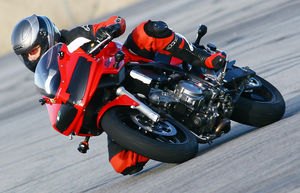







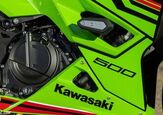


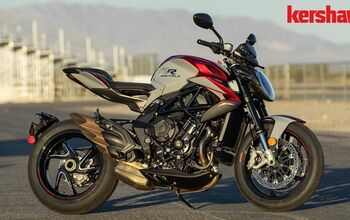

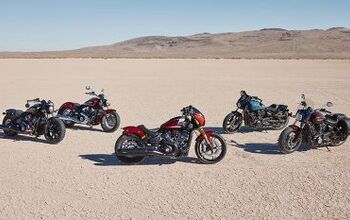







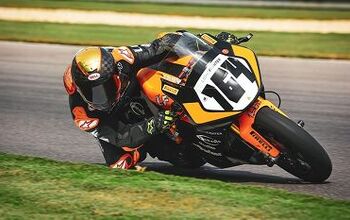
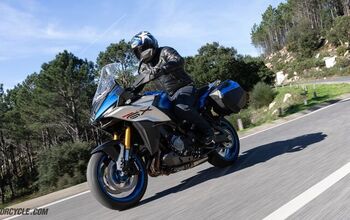





Comments
Join the conversation